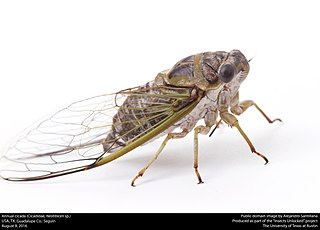
Cicadidae, the true cicadas, is one of two families of cicadas, containing almost all living cicada species with more than 3,200 species worldwide.

Pomponia is a genus of cicadas from Asia. A group of species previously placed in Pomponia, containing the largest cicada species found on earth, have recently been moved to Megapomponia. However, the remaining species still form a very heterogeneous group and Duffels and Hayashi (2006) mentioned that several species should probably be transferred to genera like Terpnosia and Leptosemia.

William Lucas Distant was an English entomologist.

The Cicadinae are a subfamily of cicadas, containing the translucent cicadas. They are robust cicadas and many have gaudy colors, but they generally lack the butterfly-like opaque wing markings found in many species of the related Tibiceninae.

Purana is a genus of cicadas from Southeast Asia. Its distribution includes Java, Sumatra, Borneo, the Philippines, peninsular Malaysia, Thailand, India, Indochina, China, and Japan. Only one species has been recorded east of the Wallace Line, Purana celebensis, from Sulawesi. In all species the male possess two pairs of dark ventral abdominal tubercles on third and fourth sternites. The male opercula are rather short and generally do not reach beyond the posterior pair of tubercles. Related genera that also possess abdominal tubercles are Leptopsaltria, Maua, Nabalua and Tanna which together with Purana are in the subtribe Leptopsaltriina of the tribe Leptopsaltriini.
Platylomia is a genus of cicadas from Southeast Asia.
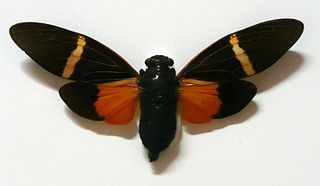
Tosena is a genus of cicadas from South-East Asia. They are the type genus of tribe Tosenini. Species formerly included in Tosena are Distantalna splendida, Formotosena montivaga, Formotosena seebohmi and Trengganua sibylla.
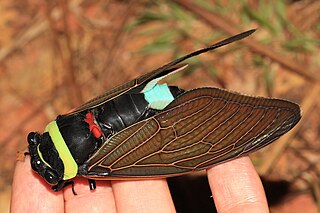
Tacua speciosa is a very large Southeast Asian species of cicada. It is the only member of the genus Tacua.

Thopha is a genus of cicada native to Australia. Five species are recognised, the double drummer, the northern double drummer, the golden drummer, T. emmotti and T. hutchinsoni. Within sessiliba, two subspecies are recognized, the nominotypical form and T. sessiliba clamoris Moulds and Hill.

Tosena albata is a cicada species from Southeast Asia. It was described by William Lucas Distant in 1878 who, however, subsequently regarded it as a variety of Tosena melanoptera. However, in 2000 Boulard confirmed the species status of Tosena albata by comparing its song with that of other Tosena species. T. albata has hitherto been recorded from Thailand, Nepal, North India, and Northwestern Himalaya
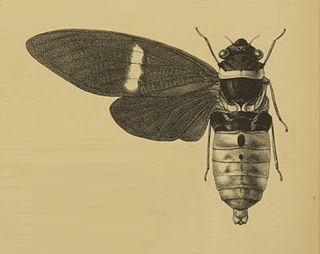
Tosena melanoptera is a cicada species from Southeast Asia. It was described by White in 1846 from material collected in North India. It has also been recorded from Thailand and Vietnam.

Formotosena is a genus of cicadas from Southeast Asia erected by Kato in 1925 to accommodate the species Formotosena seebohmi which was previously placed in the genus Tosena. Members of Formotosena are found in Southeast Asia, including southern China, Hainan and Taiwan.

The Platypleurini are a tribe of cicadas from the Afrotropical and Oriental regions There are at least 30 genera and 240 described species in Platypleurini.

The Dundubiini are a tribe of cicadas in the family Cicadidae, found in the Palearctic, Indomalaya, Australasia, and the Western Pacific. There are at least 180 described species in Dundubiini.

Maua is a genus of cicadas from Southeast Asia. The males possess two pairs of dark ventral abdominal tubercles on third and fourth sternites.
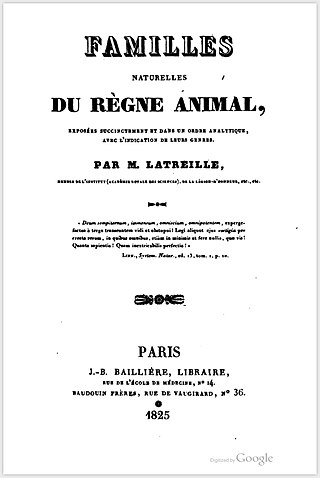
Tibicen is a former genus name in the insect family Cicadidae that was originally published by P. A. Latreille in 1825 and formally made available in a translation by A. A. Berthold in 1827. The name was placed on the Official Index of Rejected and Invalid Generic Names in Zoology by the International Commission on Zoological Nomenclature in 2021. Certain European cicada species that were included by some authors in this genus at the time of its suppression are now listed under genus Lyristes Horváth, 1926. Other formerly-Tibicen species are placed in the tribe Cryptotympanini and include the genera Auritibicen Lee, 2015, Hadoa Moulds, 2015 Megatibicen Sanborn and Heath, 2016, and Neotibicen Hill and Moulds, 2015.
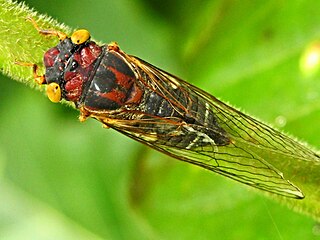
Lamotialnini is a tribe of cicadas in the family Cicadidae. There are about 19 genera and at least 90 described species in Lamotialnini, occurring worldwide except South America.

Dundubia vaginata is the type species in its genus, sometimes called the jade-green cicada in the tribe Dundubiini.


















